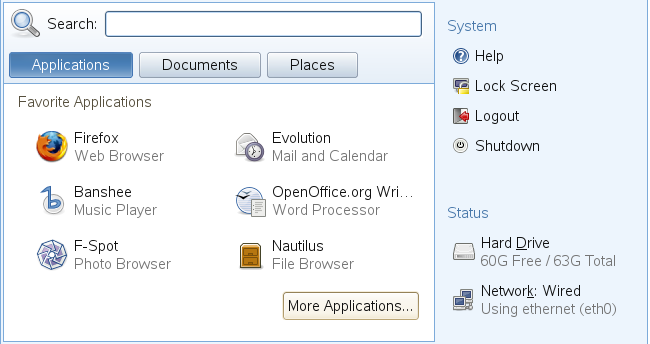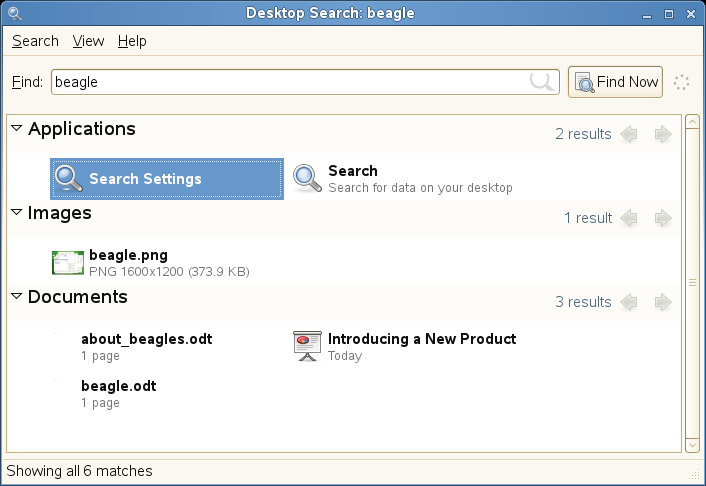1.4 Using the Main Menu
Click on the far left of the bottom panel to open the main menu. Commonly used applications appear in the main menu, along with recently used applications. You can also click to display your recent documents, or click to display your favorite places (such as your home directory or the Desktop). Click to access additional applications, listed in categories. Use the options on the right to access Help, install additional software, open the GNOME Control Center, lock your screen, log out of the desktop, or check the status of your hard drive and network connections.
Figure 1-5 Main Menu

The main menu contains several elements:
1.4.1 Search Bar
The search bar helps you find applications and files on your system. Enter your search terms in the field, then press Enter. The results are displayed in the Desktop Search dialog box.

You can use the results list to open a file, forward it via e-mail, or display it in the file manager. Simply right-click an item in the results list and select the option you want. The options available for an item depend on the type of file it is. Clicking a file in the list displays a preview of the file and information such as the title, path, and date the file was last modified or accessed.
Use the menu to limit your search to files in a specific location, such as your address book or Web pages, or to display only a specific type of file in your results list. The menu lets you sort the items in your results list according to name, relevance, or the date the file was last modified.
For more information about using the GNOME desktop’s search function, see Searching with Beagle.
1.4.2 Main Menu Tabs
You can determine which icons appear in the main menu by clicking the , , or tabs.
Favorite Applications
By default, Favorite Applications shows icons for several commonly used applications. Use this view to show the applications you use most often.
To add an item to your Favorite Applications:
-
Click .
-
Right-click the application you want to add.
-
Select .
The selected application is added to your Favorite Applications.
To remove an item from your Favorite Applications:
-
Click .
-
Make sure that your Favorite Applications appear in the main menu.
If does not appear on the main menu, click .
-
Right-click the item you want to remove.
-
Select .
The removed application no longer appears in your Favorite Applications view.
Recent Applications
Recent Applications shows the last two applications you have started. Use this view to quickly find applications you have used recently.
Recent Documents
Click the tab to display the last several documents you have opened. Use this view to quickly locate the documents you worked on most recently. Click to open the File Browser.
Recent Places
Click the tab to display the last several places you have opened. Use this view to quickly locate the places you worked on most recently. Click to open the File Browser.
1.4.3 System
System provides shortcuts to several system applications.
Table 1-3 System Shortcuts
|
Application |
Description |
|---|---|
|
Help |
Opens the Help Center, which provides online documentation for your system. |
|
Control Center |
Allows you to customize and configure your system. For more information, see Section 2.0, Customizing Your Settings. |
|
Install Software |
Opens the Software Installer, which guides you through the process of installing new software. |
|
Lock Screen |
Locks your system so that nobody can access it while you are away. Enter your password to unlock the system. |
|
Log Out |
Opens the Log Out dialog, where you can log out or switch users. |
|
Shutdown |
Opens the Shutdown dialog, where you can shut down or restart your system, or suspend the computer. |
1.4.4 Status
Status displays information about your hard drive and network connection, including the amount of available space on your hard disk and the type of network connection you are using.